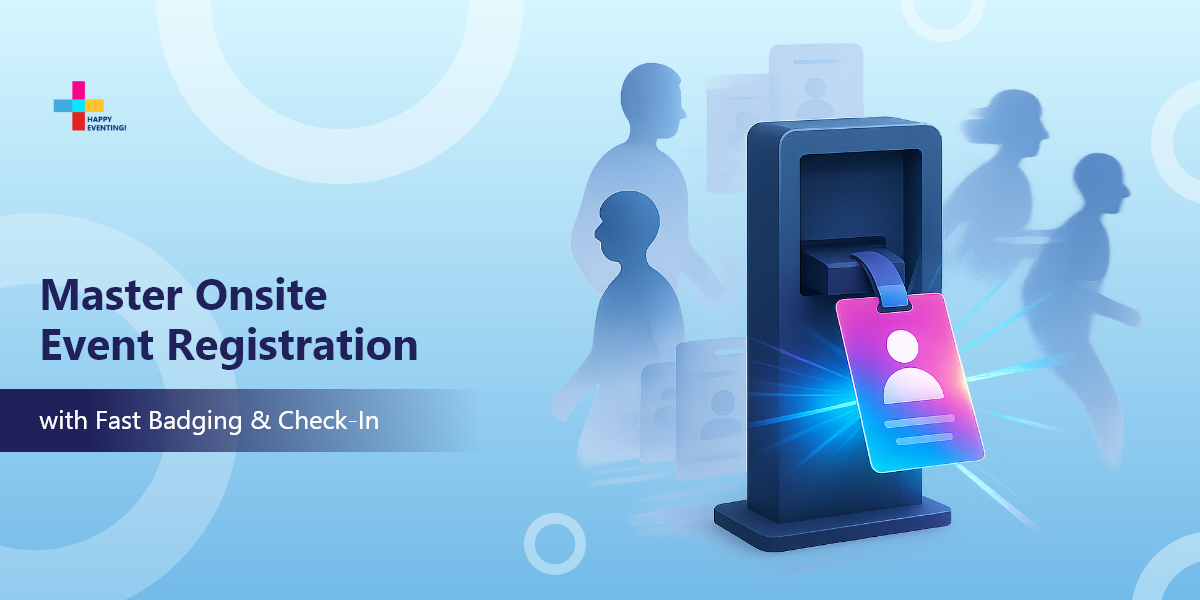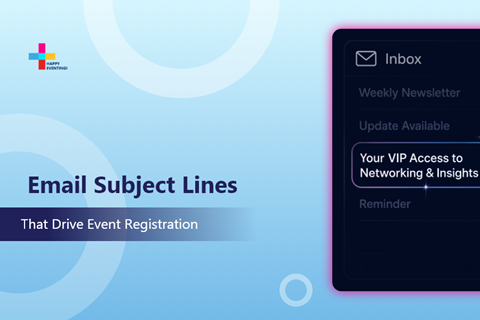

- {{UserName()}}
Request a Demo




Picture this: It's 8:30 AM at an industry tradeshow. The doors open in 30 minutes, and a crowd of 500 attendees has already formed outside the convention center. Inside, organizers monitor their registration dashboard as they prepare for 12,000 attendees expected that day.
Last year: Manual verification, name corrections, and walk-up registrations caused bottlenecks. Some attendees waited 45 minutes just to get inside. Exhibitors lost valuable face time, and organizers ended the day with incomplete data.
This year: With modern onsite event registration solutions, everything changes. Pre-registered attendees check in using badge scanning, while walk-ins use dedicated onsite counters to register. Within the first hour, 3,000 attendees are inside seamlessly. No clipboards, no delays, no missed connections.
At the core, it all comes down to streamlining registration, which includes two connected steps: onsite registration and onsite check-in with badging.
Before we dive deeper into onsite badge scanning, it's important to draw a clear distinction:
Onsite registration = for attendees who have not registered in advance and complete their signup at the venue.
Onsite check-in and badge printing = for all attendees who validate their details and pick up their credentials.
Both processes shape the first impression of your event. Getting these right ensures attendees enter smoothly, exhibitors maximize face time, and organizers capture accurate data from the start. This guide covers how to manage them effectively, from onsite registration counters to next-generation badge scanning technology.
Let's start with onsite registration itself — the foundation of the process.
Onsite event registration is the process of registering new attendees at the venue. It ensures walk-ins can still join the event while giving organizers accurate, real-time data.
This process usually involves:
Since many attendees wait until the last minute to register, a reliable onsite setup is essential. It ensures walk-ins are accommodated, keeps data accurate, and prevents missed opportunities.
Onsite check-in applies to every attendee, whether they registered in advance or signed up onsite. This step verifies their details, allows quick edits, and issues badges for access.
Modern check-in systems integrate with badge printers and scanning tools to keep the process fast and accurate. Typical steps include:
Together, onsite registration and check-in set the tone for your event — delivering faster entry, accurate data, and a smoother experience for attendees, exhibitors, and organizers.
Traditional onsite event registration and check-in often create bottlenecks. Badge scanning eliminates delays, captures cleaner data, and gives organizers real-time visibility across the venue. The right system addresses three critical areas of event success:
The most immediate impact of badge scanning is speed. Shorter lines mean attendees start the event engaged instead of frustrated. Here's how:
Every scan turns attendance tracking into powerful behavioral analytics and provides actionable intelligence for planning and ROI. Here's what organizers can track:
Badge scanning strengthens security by turning every entry into a verified record. That means organizers can:
Modern badge scanning works best when it's fully integrated with your onsite registration system, badge design, and real-time data synchronization.
The foundation of successful onsite event registration lies in smooth data flow between your registration system and badge printing infrastructure. A strong platform should:
Eventcombo already delivers this level of integration, ensuring attendee data, badges, and analytics stay connected in real time.
Choosing the right identification technology depends on your event size, budget, and analytics requirements:
|
Technology |
Best For |
Pros |
Cons |
|
QR Codes |
Most events (100–100K attendees) |
Versatile, smartphone-compatible, cost-effective |
Requires line-of-sight scanning |
|
Barcodes |
Basic check-in tracking |
Reliable, works with older hardware |
Limited data storage |
|
RFID |
Premium events, networking |
Hands-free, advanced analytics |
Higher upfront investment |
Paper badges:
PVC badges:
Printing flexibility:
Your hardware and software setup for onsite badge scanning determines both operational efficiency and staffing requirements. The right tools ensure seamless attendee experiences and allow organizers to adapt quickly.
Enable attendee-managed check-in processes that reduce staffing requirements while appealing to self-service preferences.
Key Benefits:
Always keep a staffed counter available for attendees who need assistance or troubleshooting. Eventcombo kiosks support QR scans, name lookups, and on-demand badge printing, making check-in flexible for every attendee type.
User-friendly interfaces designed for volunteer staff and temporary workers who need quick system mastery.
Operational Advantages:
Maximum mobility for staff-managed check-in while maintaining personal attendee interaction.
Flexibility Features:
Real-time information flow between all system components ensures accurate reporting and immediate issue detection. Key capabilities include:
With Eventcombo, organizers also get live dashboards that track entry patterns and session engagement, plus automatic syncing across devices.
Successful badge scanning implementation requires strategic planning that considers both technology setup and attendee experience.
Clear attendee preparation reduces confusion and maximizes efficiency:
Well-prepared staff ensure smooth operations even if technology fails:
Eventcombo provides onsite engineers and remote support, so planners never face these challenges alone.
A strategic physical layout prevents bottlenecks and guides attendees efficiently:
When selecting badge scanning solutions, choose platforms that provide comprehensive technical support:
This level of support guarantees smooth operations, no matter what arises.
Even well-planned badge scanning systems can face challenges. Here are the top four pitfalls — and their solutions:
Equipment malfunctions during peak times can create severe delays.
Solution:
Incomplete or incorrect registration data slows down check-in and causes frustration.
Solution:
Even 10-second check-ins can cause bottlenecks during peak arrivals.
Solution:
Modern attendees are cautious about data collection practices.
Solution:
Strong onsite event registration is more than just a logistical step — it's the foundation of a successful event. When done well, it ensures walk-ins are accommodated, data stays accurate, and attendees enter without delay.
Pairing registration with modern check-in and badge scanning delivers faster entry, cleaner data, verified security, and a strong first impression for everyone involved.
Ready to eliminate registration bottlenecks and unlock smarter insights?
Eventcombo's onsite solutions bring together self-service kiosks, on-demand badging, and real-time analytics, backed by onsite technical support and 24/7 human assistance. Book a demo today.

If you've ever launched a polished campaign only to see open rates stall in the single digits, you're not alone. Event registration emails often underperform—not because your event lacks appeal, but because your...

With in-person events dominating the event landscape once again, there's a growing need for platforms that can handle the complexities of on-site and virtual experiences.

Picture this: It's 8:30 AM at an industry tradeshow. The doors open in 30 minutes, and a crowd of 500 attendees has already formed outside the convention center.